Rosalind Picard
Resonance: Drawing from Memories to Imagine Positive Futures through AI-Augmented Journaling
Mar 31, 2025



Abstract:People inherently use experiences of their past while imagining their future, a capability that plays a crucial role in mental health. Resonance is an AI-powered journaling tool designed to augment this ability by offering AI-generated, action-oriented suggestions for future activities based on the user's own past memories. Suggestions are offered when a new memory is logged and are followed by a prompt for the user to imagine carrying out the suggestion. In a two-week randomized controlled study (N=55), we found that using Resonance significantly improved mental health outcomes, reducing the users' PHQ8 scores, a measure of current depression, and increasing their daily positive affect, particularly when they would likely act on the suggestion. Notably, the effectiveness of the suggestions was higher when they were personal, novel, and referenced the user's logged memories. Finally, through open-ended feedback, we discuss the factors that encouraged or hindered the use of the tool.
* 17 pages, 13 figures
A HeARTfelt Robot: Social Robot-Driven Deep Emotional Art Reflection with Children
Sep 16, 2024
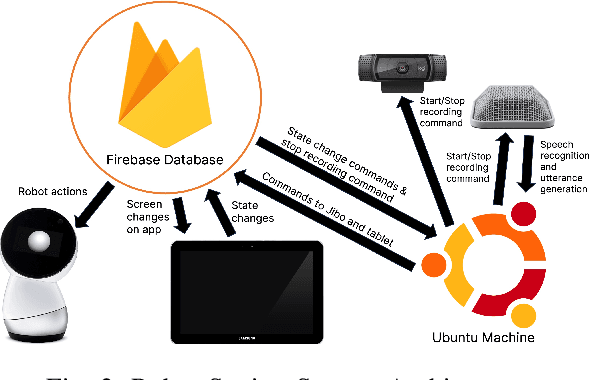
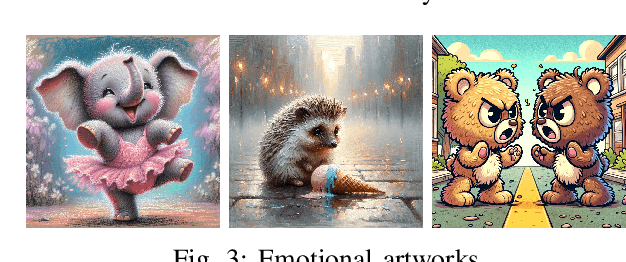

Abstract:Social-emotional learning (SEL) skills are essential for children to develop to provide a foundation for future relational and academic success. Using art as a medium for creation or as a topic to provoke conversation is a well-known method of SEL learning. Similarly, social robots have been used to teach SEL competencies like empathy, but the combination of art and social robotics has been minimally explored. In this paper, we present a novel child-robot interaction designed to foster empathy and promote SEL competencies via a conversation about art scaffolded by a social robot. Participants (N=11, age range: 7-11) conversed with a social robot about emotional and neutral art. Analysis of video and speech data demonstrated that this interaction design successfully engaged children in the practice of SEL skills, like emotion recognition and self-awareness, and greater rates of empathetic reasoning were observed when children engaged with the robot about emotional art. This study demonstrated that art-based reflection with a social robot, particularly on emotional art, can foster empathy in children, and interactions with a social robot help alleviate discomfort when sharing deep or vulnerable emotions.
Multipar-T: Multiparty-Transformer for Capturing Contingent Behaviors in Group Conversations
Apr 19, 2023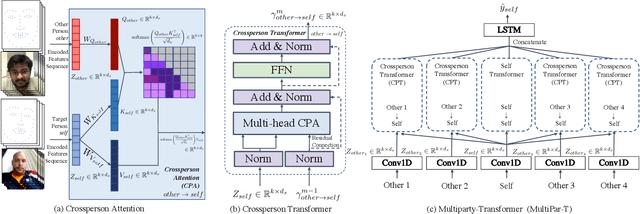



Abstract:As we move closer to real-world AI systems, AI agents must be able to deal with multiparty (group) conversations. Recognizing and interpreting multiparty behaviors is challenging, as the system must recognize individual behavioral cues, deal with the complexity of multiple streams of data from multiple people, and recognize the subtle contingent social exchanges that take place amongst group members. To tackle this challenge, we propose the Multiparty-Transformer (Multipar-T), a transformer model for multiparty behavior modeling. The core component of our proposed approach is the Crossperson Attention, which is specifically designed to detect contingent behavior between pairs of people. We verify the effectiveness of Multipar-T on a publicly available video-based group engagement detection benchmark, where it outperforms state-of-the-art approaches in average F-1 scores by 5.2% and individual class F-1 scores by up to 10.0%. Through qualitative analysis, we show that our Crossperson Attention module is able to discover contingent behavior.
Mixed Effects Random Forests for Personalised Predictions of Clinical Depression Severity
Jan 24, 2023Abstract:This work demonstrates how mixed effects random forests enable accurate predictions of depression severity using multimodal physiological and digital activity data collected from an 8-week study involving 31 patients with major depressive disorder. We show that mixed effects random forests outperform standard random forests and personal average baselines when predicting clinical Hamilton Depression Rating Scale scores (HDRS_17). Compared to the latter baseline, accuracy is significantly improved for each patient by an average of 0.199-0.276 in terms of mean absolute error (p<0.05). This is noteworthy as these simple baselines frequently outperform machine learning methods in mental health prediction tasks. We suggest that this improved performance results from the ability of the mixed effects random forest to personalise model parameters to individuals in the dataset. However, we find that these improvements pertain exclusively to scenarios where labelled patient data are available to the model at training time. Investigating methods that improve accuracy when generalising to new patients is left as important future work.
Computational Empathy Counteracts the Negative Effects of Anger on Creative Problem Solving
Aug 15, 2022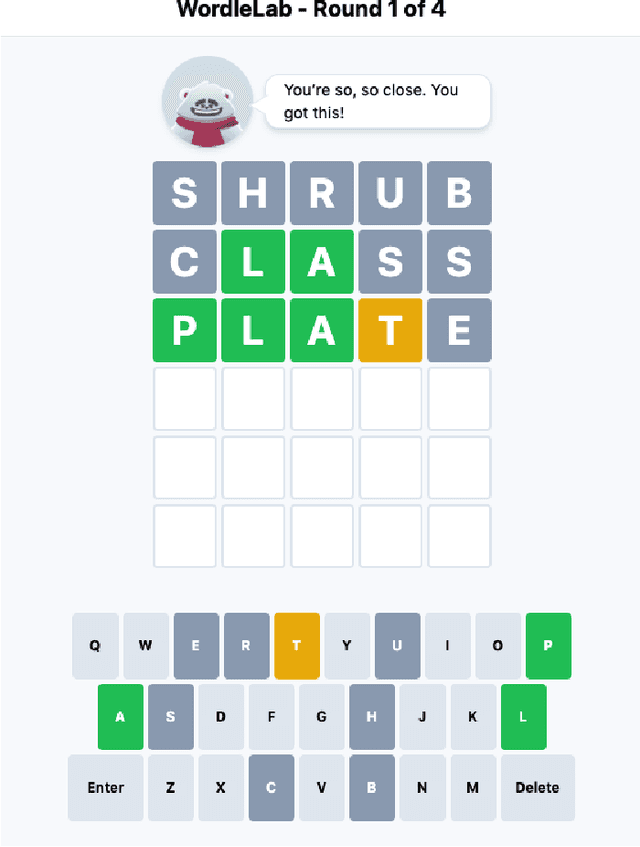
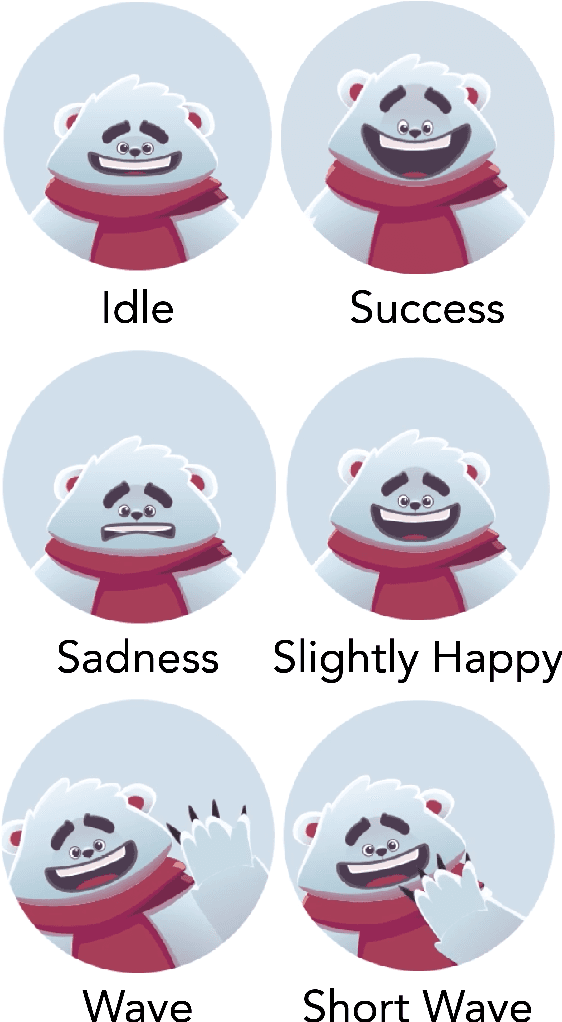
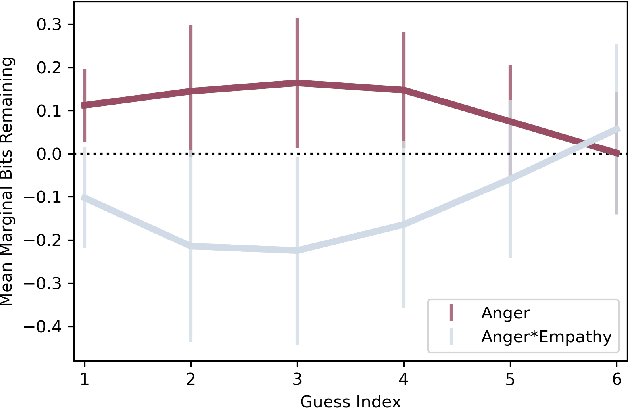
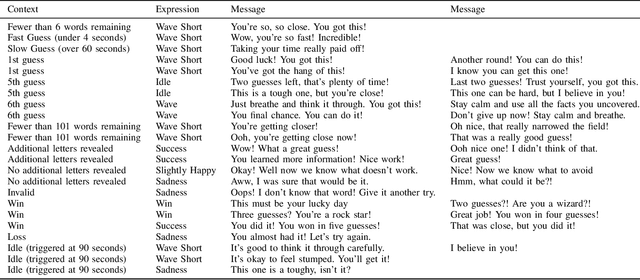
Abstract:How does empathy influence creative problem solving? We introduce a computational empathy intervention based on context-specific affective mimicry and perspective taking by a virtual agent appearing in the form of a well-dressed polar bear. In an online experiment with 1,006 participants randomly assigned to an emotion elicitation intervention (with a control elicitation condition and anger elicitation condition) and a computational empathy intervention (with a control virtual agent and an empathic virtual agent), we examine how anger and empathy influence participants' performance in solving a word game based on Wordle. We find participants who are assigned to the anger elicitation condition perform significantly worse on multiple performance metrics than participants assigned to the control condition. However, we find the empathic virtual agent counteracts the drop in performance induced by the anger condition such that participants assigned to both the empathic virtual agent and the anger condition perform no differently than participants in the control elicitation condition and significantly better than participants assigned to the control virtual agent and the anger elicitation condition. While empathy reduces the negative effects of anger, we do not find evidence that the empathic virtual agent influences performance of participants who are assigned to the control elicitation condition. By introducing a framework for computational empathy interventions and conducting a two-by-two factorial design randomized experiment, we provide rigorous, empirical evidence that computational empathy can counteract the negative effects of anger on creative problem solving.
Human Detection of Political Deepfakes across Transcripts, Audio, and Video
Feb 25, 2022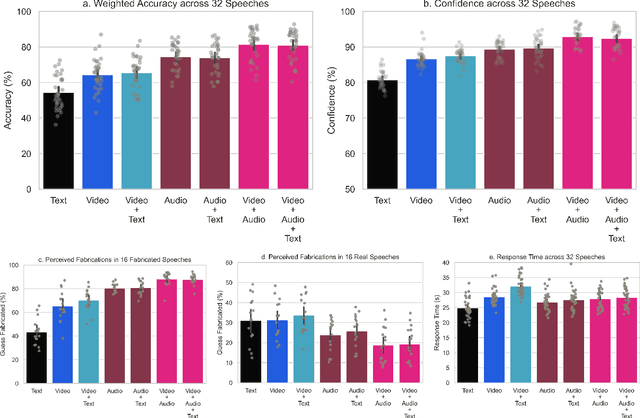


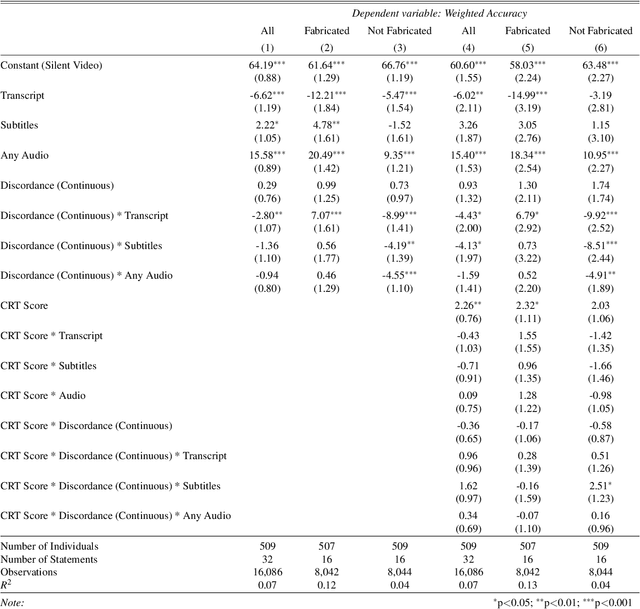
Abstract:Recent advances in technology for hyper-realistic visual effects provoke the concern that deepfake videos of political speeches will soon be visually indistinguishable from authentic video recordings. Yet there exists little empirical research on how audio-visual information influences people's susceptibility to fall for political misinformation. The conventional wisdom in the field of communication research predicts that people will fall for fake news more often when the same version of a story is presented as a video as opposed to text. However, audio-visual manipulations often leave distortions that some but not all people may pick up on. Here, we evaluate how communication modalities influence people's ability to discern real political speeches from fabrications based on a randomized experiment with 5,727 participants who provide 61,792 truth discernment judgments. We show participants soundbites from political speeches that are randomly assigned to appear using permutations of text, audio, and video modalities. We find that communication modalities mediate discernment accuracy: participants are more accurate on video with audio than silent video, and more accurate on silent video than text transcripts. Likewise, we find participants rely more on how something is said (the audio-visual cues) rather than what is said (the speech content itself). However, political speeches that do not match public perceptions of politicians' beliefs reduce participants' reliance on visual cues. In particular, we find that reflective reasoning moderates the degree to which participants consider visual information: low performance on the Cognitive Reflection Test is associated with an underreliance on visual cues and an overreliance on what is said.
Predicting Driver Self-Reported Stress by Analyzing the Road Scene
Sep 27, 2021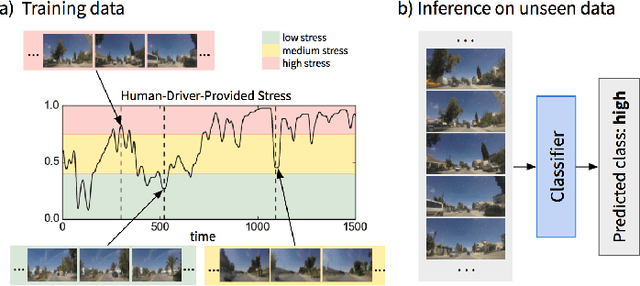
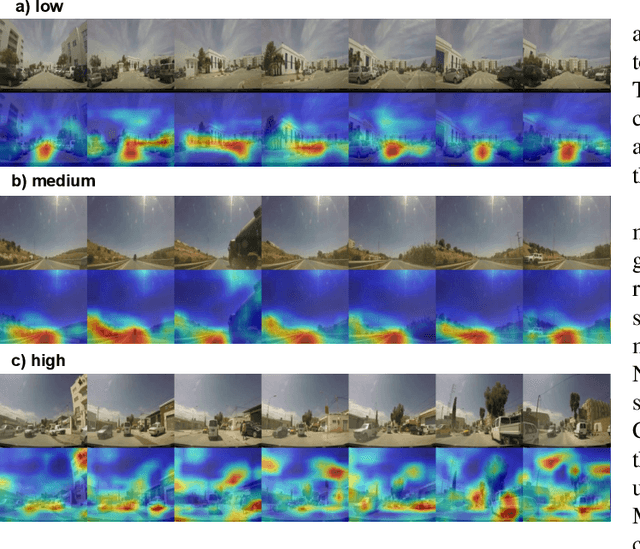

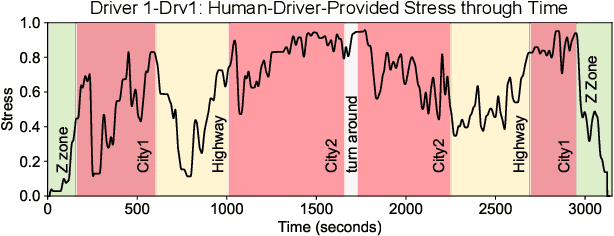
Abstract:Several studies have shown the relevance of biosignals in driver stress recognition. In this work, we examine something important that has been less frequently explored: We develop methods to test if the visual driving scene can be used to estimate a drivers' subjective stress levels. For this purpose, we use the AffectiveROAD video recordings and their corresponding stress labels, a continuous human-driver-provided stress metric. We use the common class discretization for stress, dividing its continuous values into three classes: low, medium, and high. We design and evaluate three computer vision modeling approaches to classify the driver's stress levels: (1) object presence features, where features are computed using automatic scene segmentation; (2) end-to-end image classification; and (3) end-to-end video classification. All three approaches show promising results, suggesting that it is possible to approximate the drivers' subjective stress from the information found in the visual scene. We observe that the video classification, which processes the temporal information integrated with the visual information, obtains the highest accuracy of $0.72$, compared to a random baseline accuracy of $0.33$ when tested on a set of nine drivers.
Comparing Human and Machine Deepfake Detection with Affective and Holistic Processing
May 13, 2021
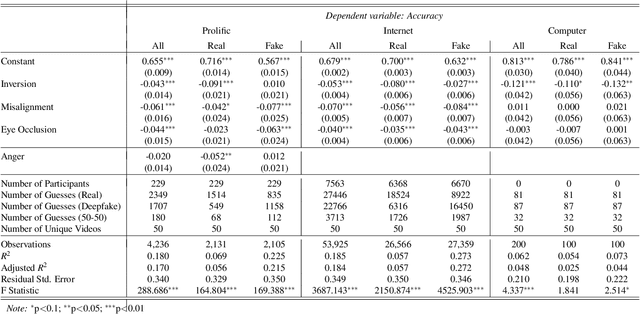
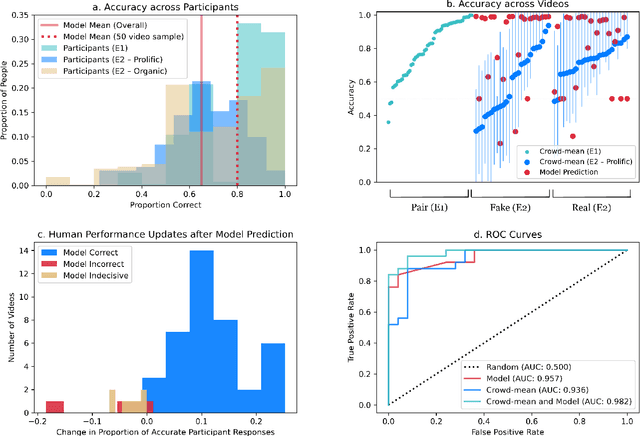
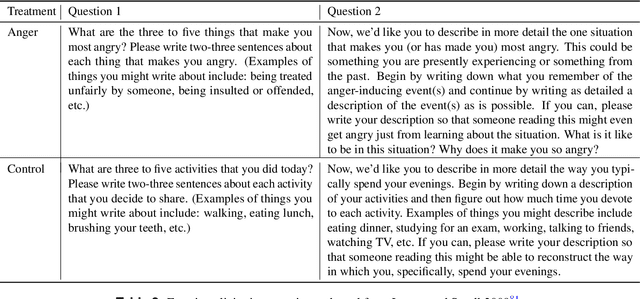
Abstract:The recent emergence of deepfake videos leads to an important societal question: how can we know if a video that we watch is real or fake? In three online studies with 15,016 participants, we present authentic videos and deepfakes and ask participants to identify which is which. We compare the performance of ordinary participants against the leading computer vision deepfake detection model and find them similarly accurate while making different kinds of mistakes. Together, participants with access to the model's prediction are more accurate than either alone, but inaccurate model predictions often decrease participants' accuracy. We embed randomized experiments and find: incidental anger decreases participants' performance and obstructing holistic visual processing of faces also hinders participants' performance while mostly not affecting the model's. These results suggest that considering emotional influences and harnessing specialized, holistic visual processing of ordinary people could be promising defenses against machine-manipulated media.
Human-centric Dialog Training via Offline Reinforcement Learning
Oct 12, 2020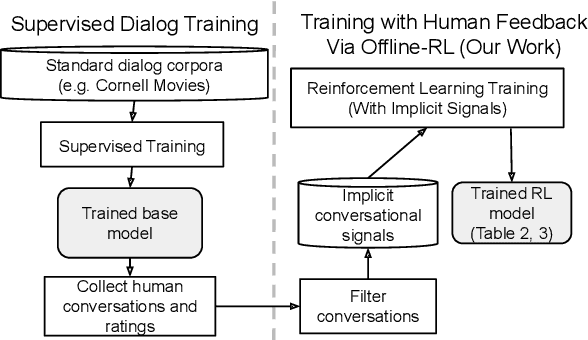
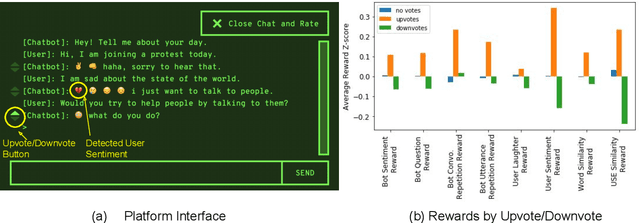


Abstract:How can we train a dialog model to produce better conversations by learning from human feedback, without the risk of humans teaching it harmful chat behaviors? We start by hosting models online, and gather human feedback from real-time, open-ended conversations, which we then use to train and improve the models using offline reinforcement learning (RL). We identify implicit conversational cues including language similarity, elicitation of laughter, sentiment, and more, which indicate positive human feedback, and embed these in multiple reward functions. A well-known challenge is that learning an RL policy in an offline setting usually fails due to the lack of ability to explore and the tendency to make over-optimistic estimates of future reward. These problems become even harder when using RL for language models, which can easily have a 20,000 action vocabulary and many possible reward functions. We solve the challenge by developing a novel class of offline RL algorithms. These algorithms use KL-control to penalize divergence from a pre-trained prior language model, and use a new strategy to make the algorithm pessimistic, instead of optimistic, in the face of uncertainty. We test the resulting dialog model with ratings from 80 users in an open-domain setting and find it achieves significant improvements over existing deep offline RL approaches. The novel offline RL method is viable for improving any existing generative dialog model using a static dataset of human feedback.
A Robotic Positive Psychology Coach to Improve College Students' Wellbeing
Sep 08, 2020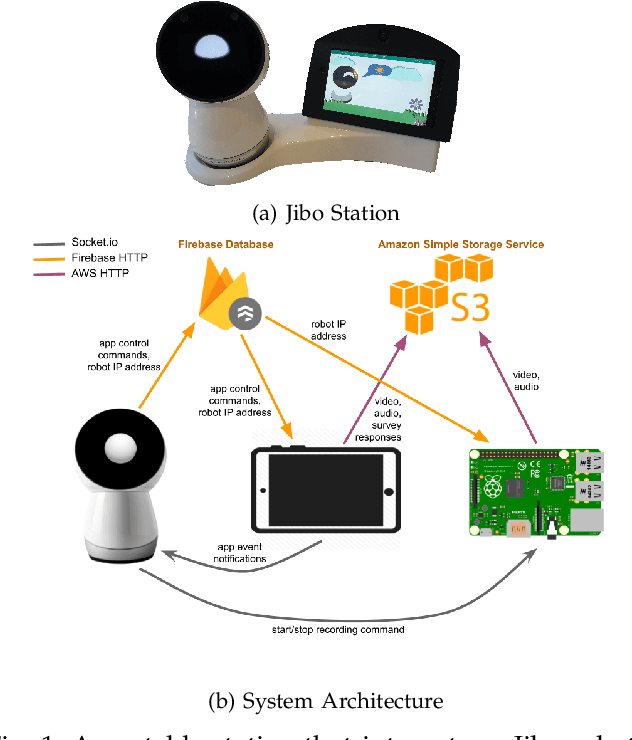
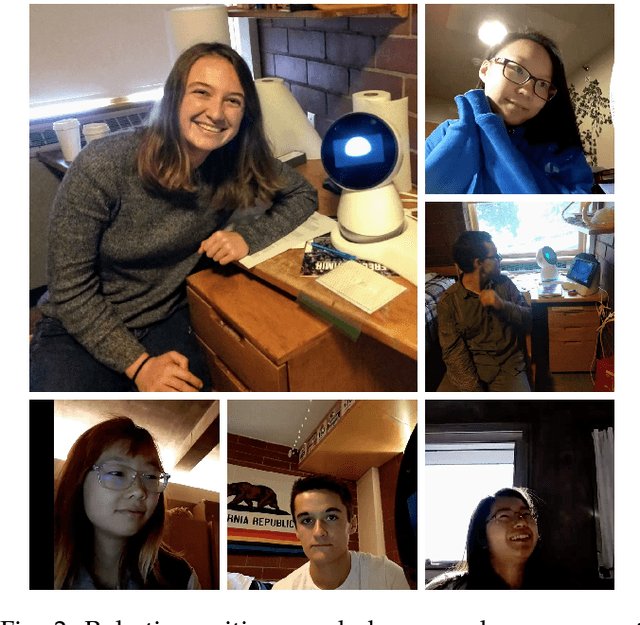

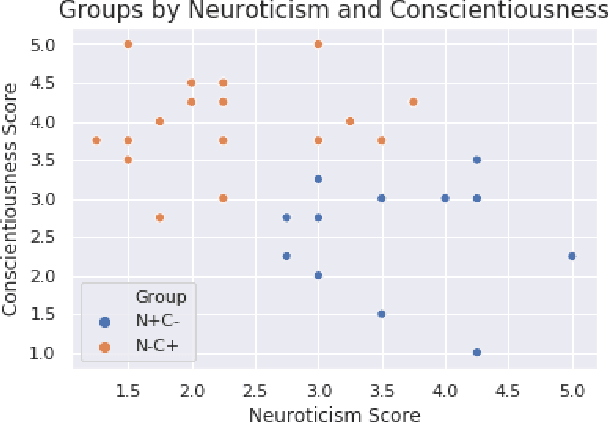
Abstract:A significant number of college students suffer from mental health issues that impact their physical, social, and occupational outcomes. Various scalable technologies have been proposed in order to mitigate the negative impact of mental health disorders. However, the evaluation for these technologies, if done at all, often reports mixed results on improving users' mental health. We need to better understand the factors that align a user's attributes and needs with technology-based interventions for positive outcomes. In psychotherapy theory, therapeutic alliance and rapport between a therapist and a client is regarded as the basis for therapeutic success. In prior works, social robots have shown the potential to build rapport and a working alliance with users in various settings. In this work, we explore the use of a social robot coach to deliver positive psychology interventions to college students living in on-campus dormitories. We recruited 35 college students to participate in our study and deployed a social robot coach in their room. The robot delivered daily positive psychology sessions among other useful skills like delivering the weather forecast, scheduling reminders, etc. We found a statistically significant improvement in participants' psychological wellbeing, mood, and readiness to change behavior for improved wellbeing after they completed the study. Furthermore, students' personality traits were found to have a significant association with intervention efficacy. Analysis of the post-study interview revealed students' appreciation of the robot's companionship and their concerns for privacy.
 Add to Chrome
Add to Chrome Add to Firefox
Add to Firefox Add to Edge
Add to Edge